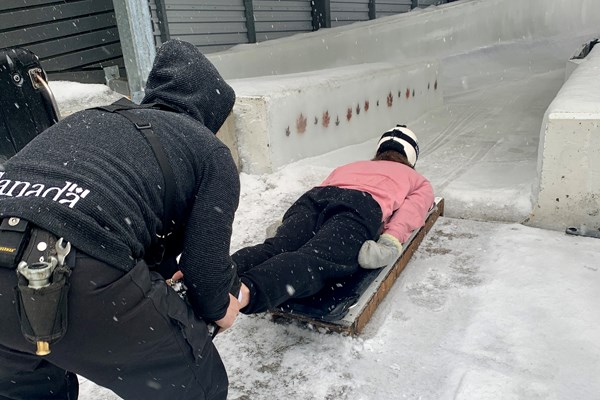Every now and then being the sports reporter in a town like Whistler brings with it a few perks. Most recently it was the chance to go ride a skeleton sled at the Whistler Sliding Centre.
Now, this sport is in no way exclusive to athletes training for competitions and sports writers who think they are good at sports. It is actually available for anybody 16 and older who meets the height and weight requirements.
At first, the idea of rocketing down a chute of ice headfirst on a sled with no brakes may seem daunting; even more so when you realize that, even starting from the bottom third of the track, you can reach upwards of 100 km/h, while athletes starting from the top routinely hit 150.
But for me, the fact that no experience is necessary put my mind at ease. Surely they aren’t sending inexperienced people hurtling down this supposed death trap if there was any actual chance of getting hurt, right? That would just be a poor business model.
So thanks to my rationalization, I walked in to the Sliding Centre with no nerves—but still without any idea of what to really expect.
After listening to the pre-slide safety presentation, which went over techniques to ensure the best run—the most important being to stay relaxed, but not limp, and keep your shoulders touching the sled at all times—myself and the seven other first-time sliders were led over to the track to be shown where we would end our run before walking up to the starting platform.
While at the Maple Leaf starting platform, named for the maple leaves literally frozen into the side walls, we meet Snowy, one of the Sliding Centre’s coaches and the man who will be giving us our push down the track.
Snowy offers us some more background on the track and the sport, and some anecdotes on how the most scared people often do the best in their first time, to which I think, “Yeah right, I got this.”
Sitting fifth in the order, I watch as, one by one, the other sliders get set up on the sled and pushed down the track.
As each slider takes off down the track, the top speed is announced over the PA system: 97.6 km/h, 96.0, 97.1, 98.1. Finally, it’s my turn, and I’m pumped. I want to be the first person to top 100 km/h.
After watching everyone else go and listening to the tips Snowy has been giving them before setting off, I lay down on the sled, shoulders at the top, thumbs locked in the handle and legs pointing straight out the back.
“Looks great,” Snowy says as he grabs my legs ready to give me a push.
Confident that I’ll be able to hit that 100km/h mark, I respond with a “Hell yeah” when Snowy asks if I’m ready to “get that bill.”
And just like that, I’m off.
First corner, no problem. Shoulders still down, chin out, keeping my eyes looking forward to what’s ahead, I’m picking up speed at an exponential rate. Second corner, my shoulder and elbow scrape up against the wall, and in reaction to the mild pain I tense up and pull my arm in as tight as possible. Then I hit another wall, followed by another, and come out of the finishing ramp ping-ponging back and forth. A complete disaster.
As I step off the track, I hear my speed… 86.1 km/h, the lowest of everyone by at least nine km/h for the entire day. I completely blew it.
Luckily, everyone gets a second run to redeem themselves. So as I walked back up the track cursing myself for the poor performance, I start going over everything that went wrong in my mind.
I must have lifted my head too much while trying to look down the track, causing me to hit that first wall. Then I tensed up and pulled my shoulder in, causing me to lose control even more—a mistake I wasn’t going to make again.
Setting off for my second run, all I’m thinking is, “Don’t look up, and don’t move your shoulders.”
Staring at nothing but the ice right under my head, I essentially go down the track blind, unsuspectingly whizzing around each corner, which was definitely more unsettling than seeing what’s in front of you. But no walls were hit, and I came around the finish with a clean run.
The PA system rings out, “The most improved athlete of the day, shaving a full three seconds off his time, is Harrison Brooks reaching a top speed of 97.3 km/h.”
It wasn’t the 100 km/h mark I was hoping for, but at least it was some sort of redemption.
And just like that, my skeleton career came and went in a total time of 1:09.59.
Find more info and book your own run at whistlersportlegacies.com. All proceeds from public programs go directly towards growing sport and supporting bobsleigh, skeleton and luge athletes.




